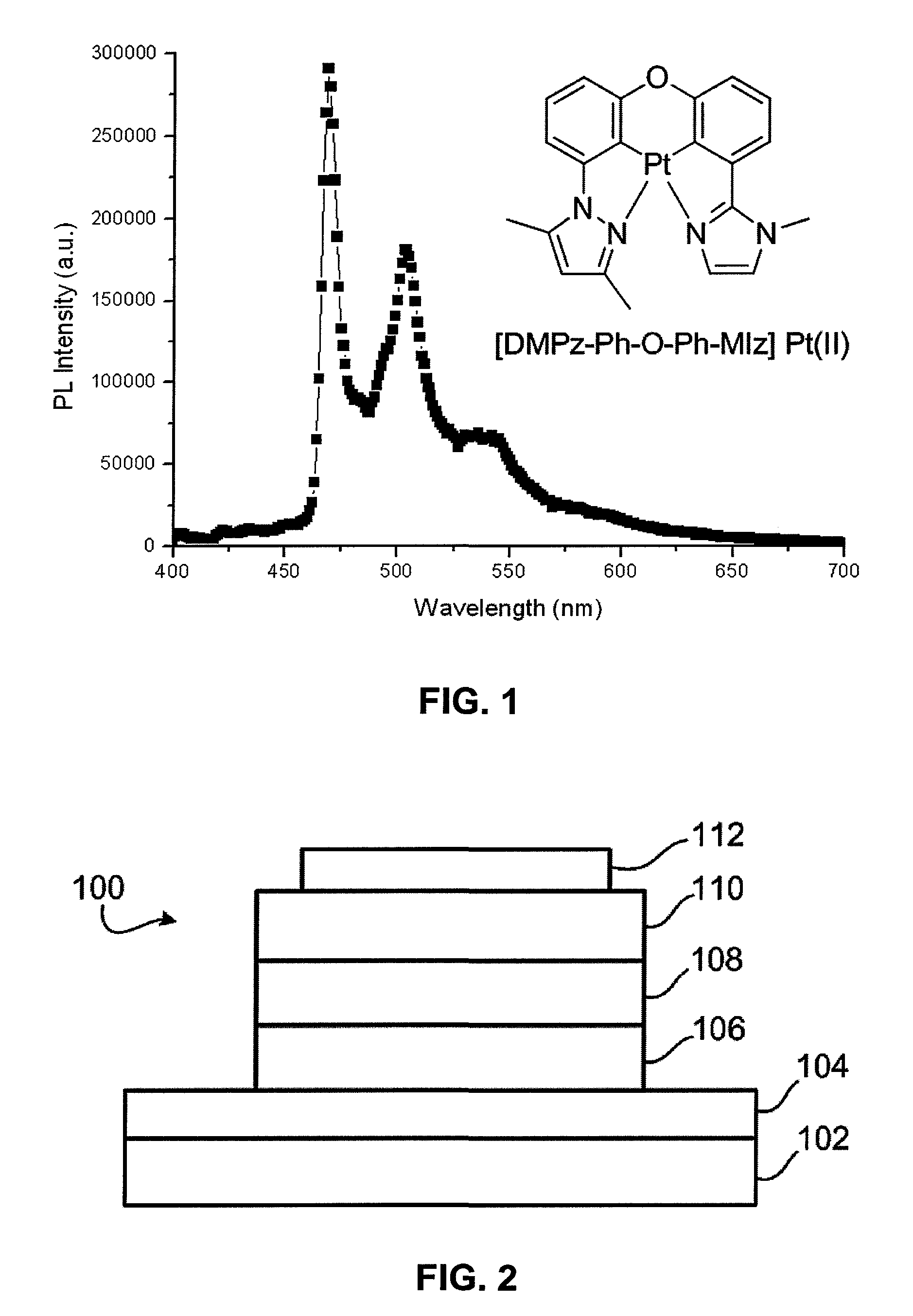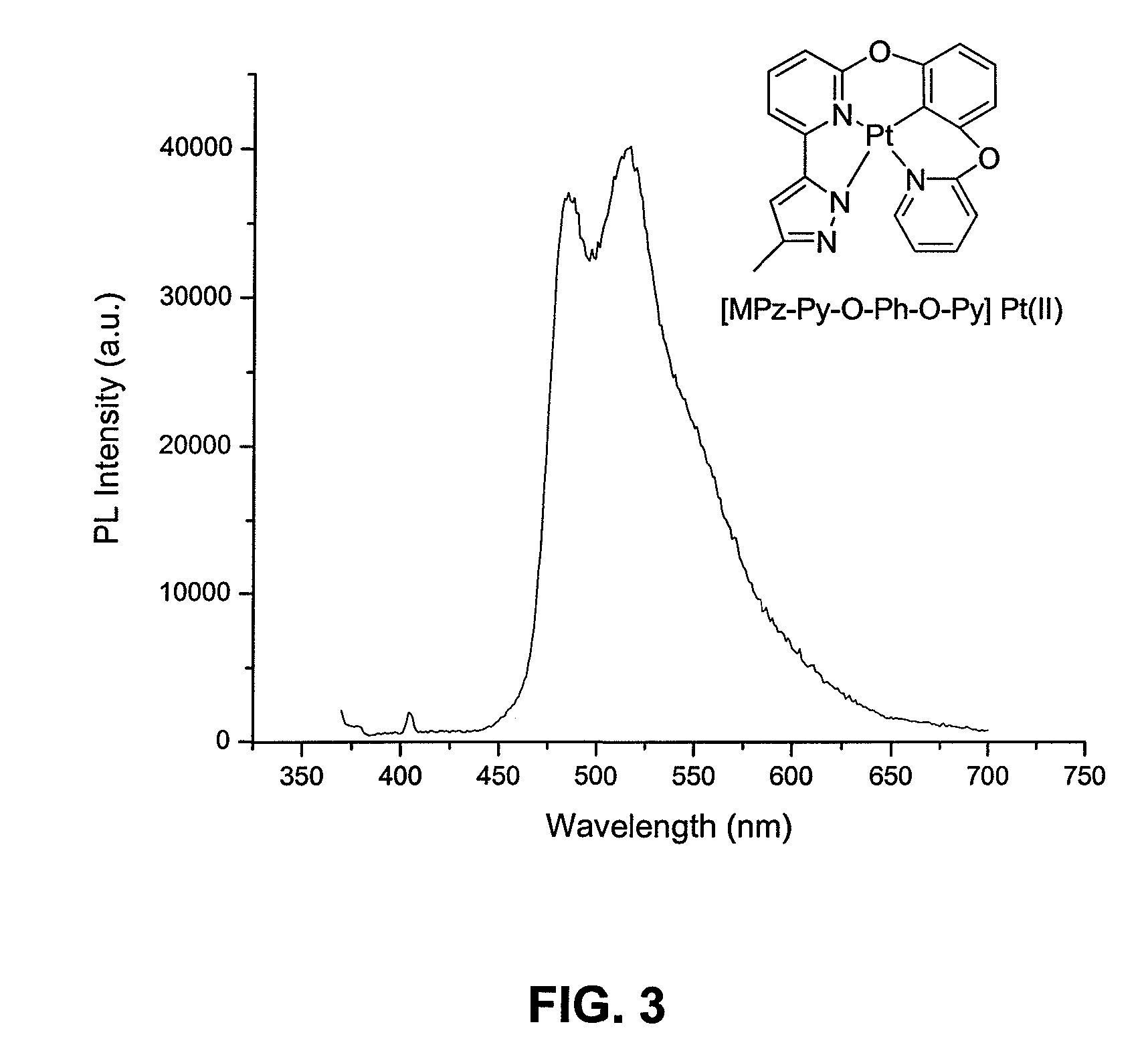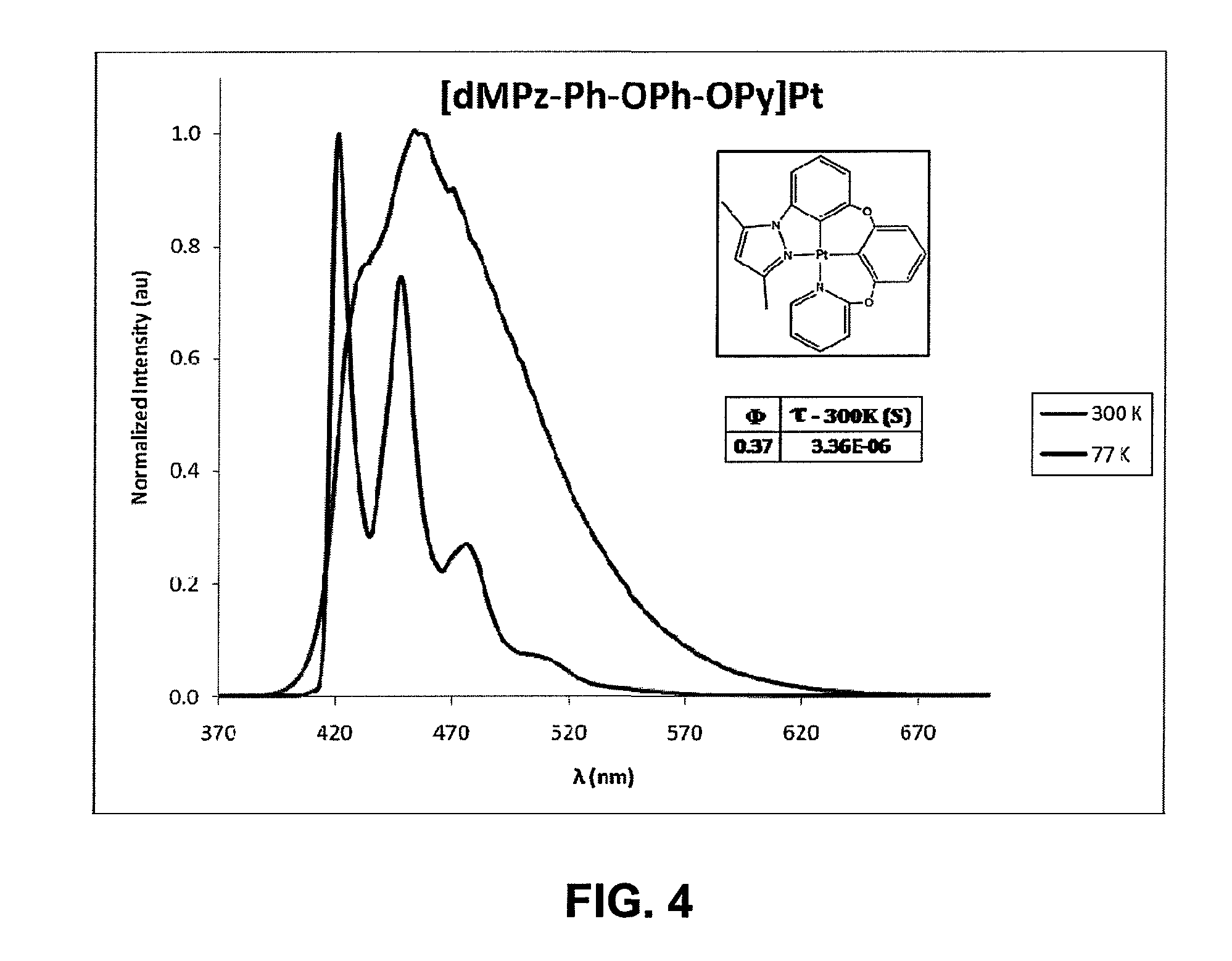Synthesis of four coordinated platinum complexes and their applications in light emitting devices thereof
a technology of platinum complexes and light-emitting devices, applied in the field of platinum complexes, can solve the problems of poor processing ability, many current devices containing organic or organometallic materials have yet to be optimized, and many materials currently used in optical and electro-optical devices
- Summary
- Abstract
- Description
- Claims
- Application Information
AI Technical Summary
Benefits of technology
Problems solved by technology
Method used
Image
Examples
example 1
Preparation of Specific Aspect [(DMPz-Ph)2-O]Pt(II)
[0165]Synthesis of DMPz-Ph-OH
[0166]
[0167]After standard cycles of evacuation and back-fill with dry and pure nitrogen, an oven-dried Schlenk flask equipped with a magnetic stir bar was charged with Cu2O (0.1 mmol, 10 mol %), syn-2-pyridinealdoxime (0.4 mmol, 20 mol %), 3,5-dimethylpyrazole (1.1 mmol), Cs2CO3 (2.5 mmol), 3-iodophenol (1.0 mmol), and anhydrous and degassed dimethylformamide (DMF) (40 mL). The flask was stirred and heated under microwave irradiation for 2 hours. The reaction mixture was allowed to cool to room temperature, diluted with dichloromethane and filtered through a plug of CELITE™, the filter cake being further washed with dichloromethane (20 mL). The filtrate was concentrated under vacuo to yield a residue, which was purified by column chromatography on silica gel to obtain the pure product DMPz-Ph-OH in 50% yield. 1H NMR (CDCl3, 500 MHz): δ2.26 (s, 1H), 2.26 (s, 3H), 2.30 (s, 3H), 5.98 (s, 1H), 6.73-6.78 (m,...
example 2
Preparation of Specific Aspect [DMPz-Ph-O-Ph-MIz]Pt (II)
[0177]Synthesis of MIz-Ph-OH
[0178]
[0179]A mixture of 3-iodophenol (3.0 mmol), 1-methylimidazole (4.5 mmol), Pd(OAc)2 (5 mg, 0.01 mmol), KI (1.0 g, 6 mmol), and CuI (1.2 g, 6.1 mmol) in degassed DMF (12 mL) was heated under Ar at 140° C. for 5 days. After cooling to room temperature, the mixture was poured into NH3 solution (10%, 50 mL), and CH2Cl2 (40×3 mL) was added. The organic phase was separated and dried (MgSO4), and the solvent was evaporated. The crude product was purified by chromatograph (silica gel; hexanes-Et2O, 4:1) to give MIz-Ph-OH as a light yellow solid (50%).
[0180]Synthesis of DMPz-Ph-O-Ph-MIz
[0181]
[0182]After standard cycles of evacuation and back-fill with dry and pure nitrogen, an oven-dried Schlenk flask equipped with a magnetic stir bar was charged with Cu2O (0.1 mmol, 10 mol %), DMPz-Ph-OH (1.0 mmol), K2CO3 (2.5 mmol), DMPz-Ph-I (1.0 mmol), and anhydrous and degassed DMAc (20 mL). The flask was stirred in...
example 3
Preparation of Specific Aspect [Py-O-Ph-O-Py-dMPz]Pt (Pt001)
[0189]Synthesis of Py-O-Ph-OH
[0190]
[0191]Under a nitrogen atmosphere, a pressure vessel was charged with a magnetic stir bar, resorcinol (110 mmol), 2-bromopyridine (100 mmol), 1-methylimidazole (5 mmol), and potassium carbonate (200 mmol). Pyridine (80 mL) was added and bubbled with nitrogen for 20 minutes before copper(I) iodide (10 mmol) was added and bubbled 10 minutes further. The vessel was sealed and heated to 140° C. while stirring. After 2 days, the solution was allowed to cool. The solids were filtered off and rinsed with a 50:50 mixture of toluene and methanol. The filtrate was reduced by rotoevaporation and 150 ml of water containing 10 mL glacial acetic acid was added and shaken vigorously. The water was decanted off and 50 mL of dichloromethane was added, forming an off white precipitate which was collected by vacuum filtration and dried with ether, resulting in the pure product Py-O-Ph-OH with a 55% yield. 1H...
PUM
| Property | Measurement | Unit |
|---|---|---|
| stability | aaaaa | aaaaa |
| photoluminescence spectrum | aaaaa | aaaaa |
| photoluminescence | aaaaa | aaaaa |
Abstract
Description
Claims
Application Information
 Login to View More
Login to View More - R&D
- Intellectual Property
- Life Sciences
- Materials
- Tech Scout
- Unparalleled Data Quality
- Higher Quality Content
- 60% Fewer Hallucinations
Browse by: Latest US Patents, China's latest patents, Technical Efficacy Thesaurus, Application Domain, Technology Topic, Popular Technical Reports.
© 2025 PatSnap. All rights reserved.Legal|Privacy policy|Modern Slavery Act Transparency Statement|Sitemap|About US| Contact US: help@patsnap.com



